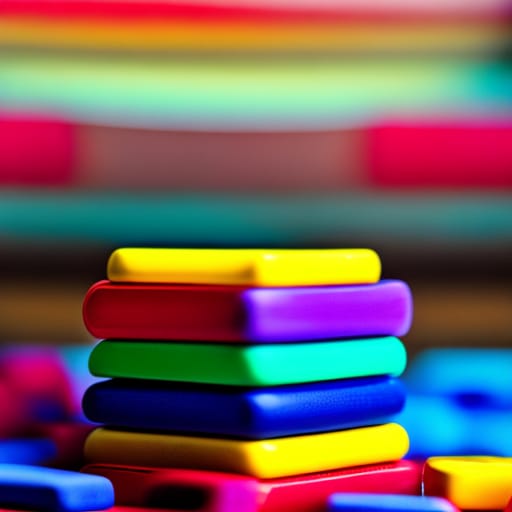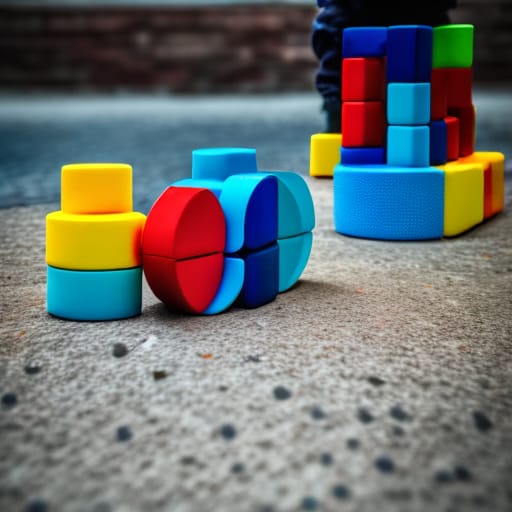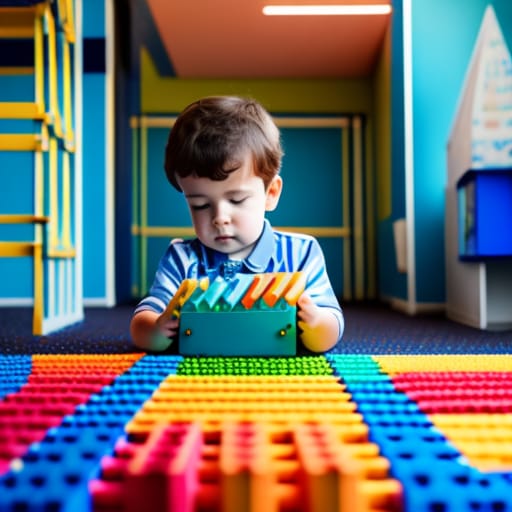Building blocks have been a staple toy for generations of kids. These simple colored blocks inspire open-ended play that builds skills in problem-solving, motor development, spatial reasoning, and imagination. As parents and educators reconsider the role of traditional toys in early education, building blocks are seeing a resurgence.
One brand leading the way in innovative building blocks is COGO. COGO makes STEM-focused building blocks designed specifically for education and development. Their expertly crafted blocks engage kids’ creativity while teaching core skills.
This beginner’s guide will explore the key benefits of COGO building blocks. Discover how they promote educational growth in young children through purposeful play.

I. Introduction to COGO Building Blocks
COGO building blocks offer a 21st century take on traditional building blocks. They move beyond simple stacking to encourage complex and creative construction play.
Overview of COGO Building Blocks
- Interlocking, interconnecting plastic bricks in bright colors
- Innovative designs like gears, motors, and tracks
- Different size sets from 30 up to 800+ pieces
- Promote skills in STEM, robotics, engineering
- Featured on popular STEM toy lists
COGO sets are made from durable ABS plastic for stability and strength. Their unique designs enable children to build elaborate structures. Gears, wheels, tracks, and motors introduce early engineering concepts.
Importance of Educational Building Blocks
Building blocks have always helped develop future-ready skills in young kids. Traits like creativity, problem-solving, and critical thinking grown through construction play.
COGO STEM blocks take it further by getting kids engaged in engineering concepts. The motors, sensors, and coding components introduce early programming skills too. This positions blocks as an educational toy ideal for the 21st century classroom.
According to child psychologists, block play builds foundational skills across domains:
- Cognitive development: mathematics, planning, sorting
- Social-emotional growth: cooperation, perseverance
- Physical abilities: eye-hand coordination, dexterity
- Creative expression: imaginative storytelling, role play
Impact on Child Development
Decades of research highlight the developmental benefits of playing with building blocks:
- Improved hand-eye coordination and fine motor control
- Understanding of geometric shapes, balance, and patterns
- Enhanced spatial reasoning and problem-solving abilities
- Growth of planning, organizing and sequencing skills
- Better focus, concentration, and attention span
Building blocks check all the boxes for an educational toy. No wonder they remain a favorite open-ended plaything for preschool and early elementary classrooms.
Brief History of Building Blocks
Building blocks have been around in some form for centuries. Wooden blocks date back to the 16th century. The first interlocking blocks resembling modern LEGOs appeared in the late 1800s.
Over the decades, block play evolved from simple stacking to elaborate model construction:
1800s – Frobel Gifts (Germany) established blocks as early education material
1930s – English and American brands launched colored wooden unit blocks
1950s – Interlocking plastic bricks emerged as affordable block alternative
1970s – Mates launched first plastic building brick with wheels
2000s – Bricks become high-tech integration with motors, lights, sensors
Today building blocks like COGO offer innovations to engage budding young builders. Their smart bricks get kids learning while having fun.
II. Educational Benefits of COGO Building Blocks
Let’s explore some of the key developmental benefits of playing with COGO building blocks:
Cognitive Development
COGO blocks boost essential cognitive abilities in children through purposeful block play.
Problem Solving Skills
To create unique structures, kids need to visually plan designs and correct mistakes. This logical thinking strengthens their budding problem-solving capabilities.
Strategizing block construction grows critical analysis too. Young minds learn how to conceptualize designs, identify structural flaws, and improvise solutions.
Spatial Awareness
Arranging blocks in patterns boosts a child’s spatial reasoning. Visualizing designs in 3D space helps understand geometry concepts. This spatial recognition is linked to improved performance in science and math.
Mathematical Concepts
Playing with sizes, shapes and patterns teaches basics of geometry, symmetry, dimensions and fractions. Sorting colorful blocks also introduces early Math concepts like grouping, categorization and ordering.
Motor Skills Development
COGO blocks help develop fine motor control and hand-eye coordination in young kids.
Fine Motor Skills
The precision needed to balance blocks activates fine motor skills. Handling the molded bricks builds strength and dexterity in children’s fingers and palms.
Twisting and turning cog wheels further stimulates their sensorimotor abilities. Over time, this repeated manipulation improves their small muscle control.
Hand-Eye Coordination
Visually guiding hands to stack blocks promotes crucial hand-eye synchronization. The precision placement integrates their vision with motor abilities. Carrying bricks across the room also develops spatial coordination.
Creativity and Imagination
Free construction play allows children to build anything they dream up. This open-ended flexibility fires up their natural creativity.
Role of Building Blocks in Creative Play
There is no right or wrong way to play with blocks – kids control the experience. Building towers, bridges, robots – they embrace engineering principles while exercising their imagination.
This autonomy promotes decision making too. Younger kids learn how to trust their creative instincts during block play.
Encouraging Imagination
As children build elaborate block structures, it sparks storytelling and roleplaying. Constructing a house may lead to creating little families who live inside. Building a garage can inspire playing mechanic.
This pretend play strengthens their imagination and symbolic thinking. Assigning narratives also builds language and storytelling skills.

III. Product Range and Features
Let’s examine some of the top-selling COGO building block sets and their unique elements:
COGO 73 PCS DIY Creative Educational Building Blocks
This introductory STEM building set has endless design options. The 73 thoughtful pieces enable all kinds of creative constructions.
Material and Package Details
- Premium durable ABS plastic material
- Vibrant non-toxic child-safe colors
- Includes mesh bag for easy storage
- Measures 23 x 23 x 6 cm fully packed
- Weighs around 1.1 lbs (0.5 kg)
- Designed for ages 3+ years
Certifications and Safety Standards
The products meet strict quality control guidelines:
- China CCC certification
- EN71 and ASTM F963 toy safety standards
- Phthalate and lead free materials
COGO 804 PCS Model Educational Building Blocks
With over 800 pieces, kids can build extremely detailed trucks, tunnels, towers, and more. The storage case keeps all the sorted bricks handy for play.
Engineering Bricks and Model Building
The set includes a mix of classic blocks and specialized pieces:
- Architectural elements like doors, windows, frames
- Transportation parts like wheels, truck beds, rotors
- Functional components like pulleys, cranks, and cogs
- Creative elements like eyes, propellers and textured tiles
Unique designs enable engineering models like cranes, airports, and robots. Detailed manual provides sample models to reconstruct.
Unique Features and Design
- Kid-friendly easy snap system – no glue or tools
- Vibrant colors identify block type and size
- Multiple shape variants from arcs, roads, to triangles
- Elements like street lights, tools, and road signs expand play
COGO Building Block Set Toy DIY Install Blocks 255 pcs
Designed for younger kids, this barnyard collection stimulates imagination and creativity. Friendly animal shapes encourage pretend play and storytelling.
Educational Toys Fruit Tree House Series Build Block
The set features:
- Animal-shaped blocks like hens, cows, sheep dogs
- Themed accessories like fences, feeding troughs, and carts
- Environment parts like barn walls, gates, pond textures
- Bright colors like red barn, yellow chick, green tree
Kids learn concepts like animal types, homes, noises, and more through play.
Function Display and Product Size
- 255 thoughtfully designed building pieces
- Packed in compact gift box with rope handle
- Assembled size: 43 x 28 x 46 cm
- Weighs around 3.85 lbs (1.75 kg)
- Ages 18 months and up
IV. Role in Early Childhood Education
Educators and psychologists confirm blocks’ immense value in early childhood development. COGO blocks take it further with their STEM-focused designs.
Use of Building Blocks in Preschools
Blocks are integral to preschool curriculum due to their multifaceted developmental benefits.
Educational Value in Early Learning Environments
Playing with blocks enables preschoolers to:
- Express creativity through unstructured construction
- Develop spatial and mathematical reasoning
- Strengthen social skills by sharing materials
- Understand concepts like stability, balance and geometry
- Integrate domains like science and art through pretend play
Incorporating Building Blocks into Curriculum
Teachers use blocks in domain-specific ways to teach varied skills:
Mathematics: Patterning, shapes, counting, sorting, classifying
Literacy: Storytelling, describing structures, writing block stories
Science: Testing designs, gravity, friction, cause-and-effect
Art: Symmetry, design thinking, expressing visual ideas
Blocks are essentially interdisciplinary learning tools for early education.
Parental Involvement and Educational Toys
Parents play a key role in fostering development too. Introducing building blocks at home provides benefits beyond the classroom.
Supporting Child Development at Home
Preschoolers learn through play, not direct instruction. Building blocks enable unstructured open play linked by research to cognitive growth. When parents engage actively – offering guidance, asking open-ended questions – block play becomes an enriching joint activity.
Some meaningful ways for parents to participate:
- Allow child to take the lead initiating ideas
- Observe firsthand their planning and problem-solving
- Ask curious questions to extend thinking
Choosing the Right Educational Toys
Look for toys like COGO blocks that align to research on developmental needs:
- Enhance multiple domains like creativity, coordination
- Promote higher-order thinking through imaginative play
- Expand with child’s evolving skills
- Withstand wear-and-tear from manipulative play
- Made from non-toxic, sustainable materials
The right blocks tick all boxes for an educational toy supporting young minds.
V. Industry and Market Insights
The global toy industry is estimated to be worth over $90 billion, with building sets making up a significant share. Educational construction toys is among the strongest growing sectors as parents and educators seek smarter playthings.
Trends in Educational Toy Industry
Key trends shaping the building blocks and educational toy segment:
Growth of STEM Toys
Parents want playthings that make kids future-ready. This STEM toy demand is expected to drive industry sales up to $25 billion by 2025. Building sets that teach coding, robotics, and design thinking skills lead in popularity.
Market Demand for Educational Building Blocks
Classic blocks are being reinvented with modern elements like gears, sensors, and apps to engage digitally native kids.
The educational building blocks market is projected to expand steadily at 13% CAGR over the next decade. Increasing use of block play in early STEM learning is fueling steady sales.
Toy Safety and Certifications
Reputable toy brands recognize child safety as imperative. COGO building blocks comply with all major toy quality standards.
Importance of EN71, ASTM, and Other Certifications
Toy certification ensures product safety across metrics like:
- Chemical composition
- Choking hazards
- Age labeling
- Fire resistance
- Electrical safety
Ensuring Toy Safety and Compliance
COGO thoroughly tests materials for toxins like lead and phthalates. Their manufacturing process guarantees strict conformance to codes like EN71 and ASTM.
This upfront compliance offers peace-of-mind when selecting best toys for kids. Checking for major safety marks reassures of due diligence by toy brands.

Final Takeaways
COGO building blocks offer the perfect blend of fun and functionality. Their smart brick sets build crucial cognitive, motor, and creative skills in early learners. These interlocking blocks also introduce foundational STEM concepts through purposeful play.
Made from non-toxic ABS plastic, COGO blocks comply with all international toy safety norms. This makes their expertly designed construction sets ideal developmental toys for young kids.
So gift the gift of lifelong learning this holiday season with COGO building blocks. Let imaginative block play equip budding little builders with essential skills to flourish.
References
[1] Lindeman, K.W. (1999), The Block Book
[2] Hirsch, E. S. (1996). The Block Book
[3] Beloglovsky, M. and Daly, L. (2015). Loose Parts: Inspiring Play in Young Children
Frequently Asked Questions
What are the benefits of COGO building blocks for child development?
COGO building blocks promote cognitive growth, fine motor skills, spatial reasoning, mathematical concepts, creativity, and imagination in young children. Constructing with blocks develops crucial skills including problem-solving, hand-eye coordination, engineering principles, and design thinking.
What makes COGO blocks different from regular building blocks?
COGO blocks add innovations like gears, motors, tracks, and sensors to classic block play. These introduce early coding, robotics and engineering concepts not found in regular blocks. Their thoughtful designs uniquely promote STEM learning through creative construction play.
What age are COGO blocks suitable for?
COGO makes block sets suitable for kids 18 months to 12 years old. Their preschool sets have animal shapes, bright colors, and pretend play value. Primary grade sets feature more complex builds like cranes, airports, and robots that develop spatial and analytical abilities.
Do COGO blocks help develop skills for school readiness?
Yes, research shows playing with blocks boosts cognitive abilities, social skills, motor dexterity, and emotional regulation. These school readiness skills give young kids an academic edge in kindergarten and beyond. Purposeful play is how preschoolers build future success.
How are COGO blocks used in early education classrooms?
Teachers incorporate block play across domains like math, science, art and literacy. Open-ended construction nurtures curiosity, focus, planning, and inventiveness. Guided play develops skills like sorting, patterns, symmetry, storytelling, cooperation and problem resolution.
What safety certifications do COGO blocks comply with?
COGO toys meet or exceed major toy safety codes including EN71, ASTM F963, CCC, CE and more. Their manufacturing facilities follow strict quality control processes. Multi-point inspections ensure no toxic chemicals or hazards. This upfront compliance offers parents peace of mind.